
..........................................................................................................................................................................................................
trek domane 5.9
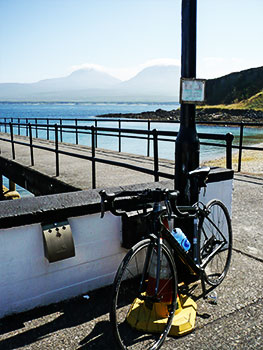
we may, by now, have passed the point of no return in bicycle nomenclature. while even as recently as the beginning of this century it may have been still valid to discuss down-tubes, head-tubes and even seat-tubes, the onward march of carbon fibre construction has all but rendered such terminology null and void. the trek domane is perhaps an excellent example of this. whether its profile and/or cross-section is necessitated by torsional or aerodynamic considerations i'm truly not very sure, since most of the little information i have on frame design harks back to the days of steel tubing held together with steel lugs.
the double-diamond construction remains, but such are the winding ways of carbon monocoque construction, that no longer does each part of the bicycle frame exist as a discrete unit. you need only view the conjoining of what would previously been referred to as the top, head and down-tubes to see what i mean. it's hard to tell where one stops and the others start. this illusion is compounded by witnessing both the rear brake cable and electric gear cable disappearing into holes in that head-tube, the former making its exit from the extremely flattened section of the top tube, before continuing to the rear caliper.

the one bit i do think i comprehend is the mellifluous modelling of a flattened down-tube merging seamlessly with an all too narrow seat-tube, a structure that flattens as it widens in order to accommodate the somewhat colossal proportions demanded by the bb90, press-fit bearings. stiffness is still the name of the game, and such enormity seems the only pragmatic method of dialling-in this requirement on monocoque carbon.
which is partially ironic, for the domane (pronounced dom- annie) is trek's comfortable bike, aimed squarely at the sportive market, and featuring a slightly longer wheelbase than that of its madone brethren. the fact that radioshack/trek's fabian cancellara has ridden this frame to good effect in the cobbled classics, ought surely to promote the enhanced comfort to which trek lay claim.
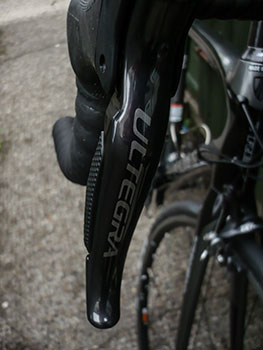
so why build a frame that has stiffness at its heart, yet do all in your power to make it more comfortable? surely lowering the stiffness quotient would achieve the same end? well, quite possibly that would be the case were we discussing more conventional materials, but carbon it seems, has the modelling versatility of plasticine; very stiff plasticine. for in order that input at the pedals might result in unhampered forward movement, that stiffness has need of being there. perhaps not quite in the shovelfuls that will attract cancellara, but it would be impractical, not to say inordinately expensive, to build one bike for the pros and something altogether different for the rest of us.
bearing this in mind, trek's iso speedlink feature at the seatpost end of the top tube contains the essence of that comfort factor without which we may be less inclined to try riding an entire sportive. this feature does, in fact, decouple the seat-tube from the rest of the frame, allowing it to absorb more road-shock without compromising the stiffness of the rest of the frame. though i have little doubt that such carbon engineering has basis in fact, it's just a shame that it has to have rather meaningless decals applied, such as power transfer construction at the bottom end of the down-tube where no-one can read it.
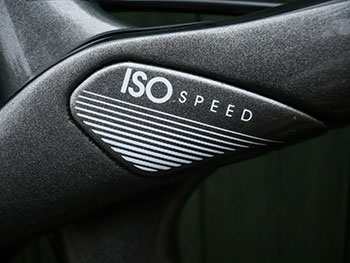
additionally, there's a small decal on the rear at the bottom of the seat-tube that states bb90. rather pointless in my opinion, but it would be wrong to accuse trek alone, since it's something that seems endemic to the modern bicycle industry.
what is signified on the frame is its asymmetric attributes, rather undermining pinarello's claim that the dogma is the only asymmetric frame on the market. it would appear this loss of symmetry is attributed to the left chainstay which does not exactly mirror its right-hand compatriot. additionally, the left attests to its readiness to accept a duotrap computer sensor with no unsightly sensor sitting obliquely on the frame. sadly that is rather offset by the bulk of the ultegra di2 front mech. gearing has never looked so ugly.
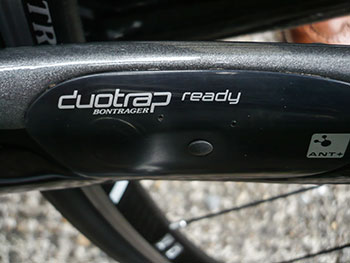
the carbon forks differ considerably from more regular fare in that they feature a slight curve on the way to the dropouts. and though it's not immediately apparent, if you remove the front wheel (via those annoying lawyers' tabs), it is notable that the dropouts appear to point slightly rearwards. i don't doubt this is some form of compromise between fork rake, wheelbase and castor angle, but i'm happy to admit i'm not clever enough to work that out.
the frame's penchant for enormity can be plainly seen on other areas of the domane. a tapered steerer increasing from 1.125" at the top to 1.5" at the fork crown requires a head-tube that will accommodate an appropriate fsa semi-integrated headset. the steerer in this case was topped with an alloy bontrager rl 120mm stem clasping a pair of similarly monikered pair of shallow drop bars. though i doubt it carries the same baggage that was once the case, i'll admit i was suprised to see a sizeable and not altogether decorative made in taiwan sticker atop the front of the head-tube.

in fact the entire component line seems to have been drawn from the house of bontrager; wheels (18 spoke radial front, 24 spoke two-cross rear), tyres and saddle all bore keith's logo with an rl suffix. and it's probably worth mentioning that, in a trend i wholeheartedly approve of, the bontrager tyres were of 25c cross-section, as opposed to the allegedly more sporting 23c to which we are more used.
this is the very bicycle for which i was measured during a visit to alpine bikes' glasgow trek centre earlier this year, and i recall looking at the bike at the time and figuring the seatpost had managed a clever optical illusion. for at the seatpost clamp, it appeared the seatpost was of greater diameter than the tube into which i supposed it was fitted. oh how wrong can one be? in a compromise between a standard seatpost and those integrated seatmasts that were all the rage a few years ago, the seatpost is sleeved over the top of a much shorter integrated seatmast.
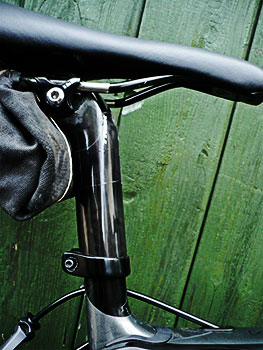
according to alpine's matt cutler, this allows trek to continue the isolink methodology while making it a tad easier to fit the bicycle into a standard bike bag/box. while that makes perfect sense, it does mean that you're tied into the trek system for the life of the bike. no eager searching for aftermarket seatposts. there may just be a soupcon of marketing involved with this factor, but in practice it's unlikely to cause much concern.
of course, as ever, the bicycle has need of componentry if we're ever going to find out just how well that frame decoupling actually works, and in this case, it all arrives courtesy of shimano. it's also a sign of the times that such componentry inhabits the realm of electronics. the ultegra di2 instance of this groupset consists of sti units, rear and front mechs, along with the obligatory internal wiring loom. the battery perches rather dangerously i thought under the bottom bracket, and considering the parlous state of islay's roads, i had fears for its safety, fears i might add, that were totally unfounded. naturally enough the bicycle arrived with the concomitant battery charger, but it remained unused throughout, despite covering nearly 700km in the process of the review.
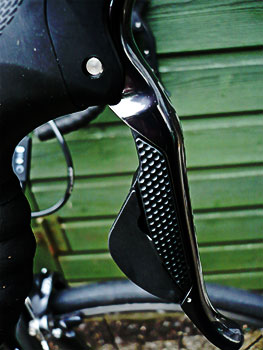
the ultegra chainset is of the compact variety, offering a 50 tooth outer ring, coupled to a 34 inner. but what came as something of a surprise, despite the domane's positioning at the sportive end of the market, was a 12-28 rear cassette. up until this particular instance, even sportive bikes have retained a 25 tooth large sprocket. the 28 offers a very knee friendly 32" gear, though just how desperately needed that is in the uk, i wouldn't like to hazard a guess.
the uci have yet to see fit to allow disk brakes in approved competition, so for the time being, stopping power was supplied by mechanical dual-pivot calipers. all the ultegra components are coloured a rather dull grey, in this case matching rather well with the domane's black and metallic grey paint scheme. it matched the garmin almost too perfectly. if only all treks were coloured as those used by radioshack in this year's tour de france, the world would be a brighter place.
that comfortable ride

i am a fool to myself. but then you knew that anyway. just because the manufacturer has invested a great deal of research and development cash, followed by a similar amount on marketing, it's not necessarily a certainty that the difference between what i'm used to riding and what i'm reviewing is going to be, to use portland terminology, awesome. of course, that is a modest sleight of hand on my part, for though i wasn't sure quite what to expect, i cannot deny that i had prepared myself for the equivalent of a parker -knoll sofa on two wheels.
racing bicycles, whether aimed at the sportive market or otherwise, are never going to be like that, and initially, i could detect little difference between the domane 5.9 and the less technologically advanced cycles in the bikeshed. there is a subset of exotica that gives you a good slap in the face from ride number one, but in mitigation, none of those have any designs on sportive rides. the domane, by its own admission, is geared very much in this direction; in that respect, it must be considered a qualified success.

it's very often quite difficult to notice something that's not there, but trek's isolation of the seat-tube from the remainder of the frame seems to have comfortably removed any semblance of perceived discomfort. despite rapidly deteriorating road surfaces and a healthy spread of cattle-grids, i could have cheerfully ridden this machine all day, were it not for a nagging irritation on the front end of the bicycle.
for reasons which continue to escape me, despite proof to the contrary, argyll & bute roads department insist on ruining perfectly good road surfaces by peppering them with so-called surface dressing. i don't doubt this is an attarctively cheap option, but it demonstrably doesn't work. in a matter of a few years, the apple crumble scattered over a thin coating of tar has worn to the point of serial discomfort for anyone on a bicycle. while the iso-link cossetted my bum from its iniquities, the same could not be said for the wheel/fork/headset combination.
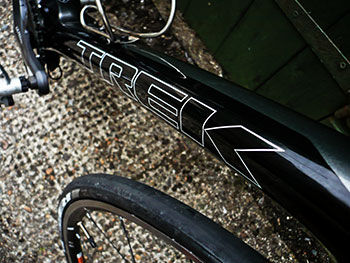
if i'm honest, and based on little more than educated conjecture, i think it may be the fault of those eighteen radial spokes and a headset hell-bent on the proselytisation of stiffness. i may be overstating the case somewhat, for i think it likely that the modest discomfort experienced through the alloy bontrager bars is not substantially greater than any comparable bicycle, but relative to the attested seated comfort, it comes across as a tad harsh. on the plus side, that front end stiffness offers superior tracking; cornering is a positive joy, and something of a godsend on scrabbly, gravelly descents at whatever speed their pilot was able to bear.
with a pair of bontrager 25c tyres fitted, i had rather hoped they'd ameliorate this inveterate chattering, and to an extent, if lowered to 80psi, there was some softening of the effect, but aside from perhaps increasing the chance of a puncture, nobody really wants to lose that 100psi zing. do they?

with many a modern day gran fondo or sportive resplendent in as many climbs per inch as the organisers can cram, there's no doubt that a twenty-first century entrant is going to need a bicycle that goes uphill as well as, if not better than it travels the flat road ahead. if the domane has a unique selling point it's one that is concomitant with such aspirations. lift that cossetted bum off the bontrager saddle and give the frame a smidgeon of welly on the ascent and i defy you not to smile in the process. each pedal stroke has a beautiful follow through that seems designed to throw out more power than is being imparted at the knees. and the harder and longer you work, the more attractive this feature becomes.
if trek could bottle this factor, they'd make a fortune.
when offering the world and the peloton my rather poor marco pantani impersonation, i rather enjoy climbing in the drops. during my fitting session at alpine bikes' glasgow trek centre, matt cutler decided that i ought to have the stem angled up rather than down in order to provide the optimum riding position. this was his masterstroke, for couple the chosen angle with shallow drops, and it's an orientation with which i found great favour. riding for kilometre after kilometre on the lower portion of the bars was quite fabulous. doubtless i also looked particularly athletic to innocent bystanders.

those drop bars also made it a simple matter to press the buttons on the ultegra's sti units from wherever the hands gripped. ultegra switches give a little more physical feedback on each gear change compared to earlier version of dura-ace di2; not quite to the extent that you'd figure you were actually moving a lever, but sufficiently to offer the positivity of an actual gearchange. it's still only possible to change up or down the cassette one gear at a time, but in truth, a little foresight ought not to drop you in the position of needing more teeth than one click will achieve. though there is a small chaincatcher inboard of the bulky front mech, i did once manage to drop the chain onto the bb shell moving from big to little ring; an upshift on the left lever bailed me out of that one with no fuss.
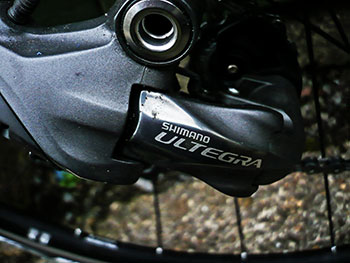
twenty-eight teeth on the big sprocket strikes me as slight overkill, though take me to provence for a day or two, and i'm sure i'd wonder why there wasn't something bigger available. however, it has messed with the sprocket sequence at the back, meaning that old front lever one-two step made itself known more often. as a smaller sprocket was reached for, the chainline demanded an upward shift to the big ring, followed swiftly by an upshift at the rear because the resultant gear was a mite too large. it's a feature i think has to be accepted with compact chainsets.
i rode a lot of kilometres on the domane, a lot of kilometres of great joy. not only do i think i could get to like electronic shifting, but the frame's subtleties behaved just like a good joni mitchell album,
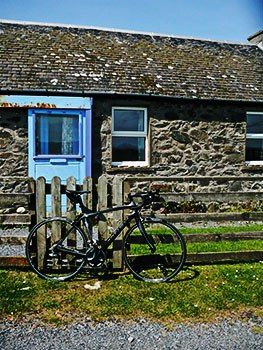 offering new realisations each time it was played. i can't say the ultegra brakes differed from the sharpness i've found with shimano calipers on previous review models, but at least i knew it was likely to happen. locking up the back wheel happens just a wee bit too often for my liking, but that's more likely pilot error than mechanical impropriety.
offering new realisations each time it was played. i can't say the ultegra brakes differed from the sharpness i've found with shimano calipers on previous review models, but at least i knew it was likely to happen. locking up the back wheel happens just a wee bit too often for my liking, but that's more likely pilot error than mechanical impropriety.
the domane 5.9 is a great bike. it won't frighten the horses at any point, but that's probably a good thing. it's well-rounded, predictable within each rider's limits and fulfils every word of those pointless decals. it's also impressively light without any serious attempts to make it so. the more you put into it, the more it pays you back, but if you ever get hold of one, spend several days riding uphill out of the saddle. for me that was the clincher.
the trek domane 5.9 full carbon frame as reviewed retails at approximately £4,500. many thanks to bryan shedden and matt cutler at alpine bikes glasgow for assistance with this feature.
